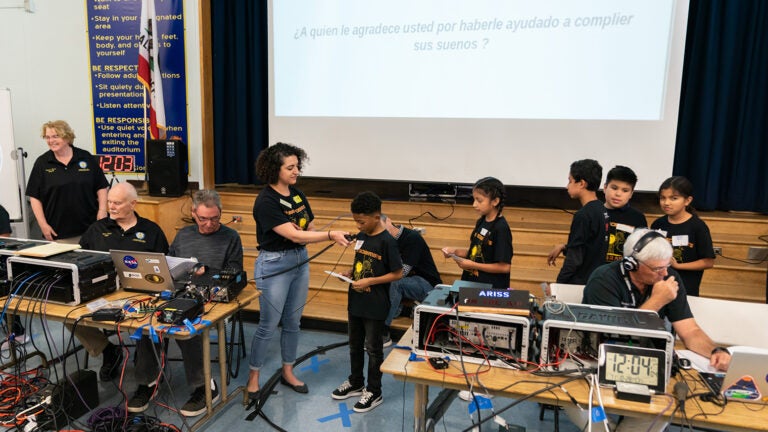
Underserved grade school students to International Space Station: Do you read us?
“November-Alpha-One-Sierra-Sierra, this is Kilo-November-Six-Charlie-Hotel-Sierra.”
Inside the packed auditorium at Vermont Avenue Elementary School near USC’s University Park campus, 270 third-, fourth- and fifth-graders held their breath, along with teachers, parents and local amateur radio enthusiasts, as USC’s Rita Barakat, a Ph.D. candidate in neuroscience, attempted to establish contact with the International Space Station (ISS).
This was the doctoral student’s seventh attempt, and so far, loud static had been her only reward. Undeterred, Barakat, a coordinator at the Young Scientists Program (YSP) based at the USC Dornsife College of Letters, Arts and Science, tried again.
“November-Alpha-One-Sierra-Sierra, this is Kilo-November-Six-Charlie-Hotel-Sierra.”
More crackling, then a disembodied male voice emerged from the static: Italian astronaut Colonel Luca Parmitano, ISS commander, responded, “We hear you loud and clear. Go ahead with your questions.”
Loud whoops of excitement went up from the grade school students, then quickly returned to hushed silence as the students focused on 10 of their peers lined up at the front of the room. The 10 had been selected to quiz Parmitano about space travel and life on the space station as the ISS passed over USC and downtown Los Angeles.
Held on Oct. 28, the event was organized by YSP, a part of the Joint Educational Project (JEP) based at USC Dornsife.
The students were also excited because this was a historic event — the first time that L.A. elementary students had spoken with astronauts on the space station. Their school, a member of the USC Family of Schools, was one of just 15 places worldwide authorized to make contact with the ISS in 2019.
Questions and answers
Among the students who got to ask Parmitano two questions each was 10-year-old Melody Castro, a fifth-grader and enthusiastic YSP member. She and the others were selected after their questions were chosen from more than 500 submitted. She asked Parmitano “what encouraged you to be an astronaut?” and “when you were younger, did you want to be an astronaut?”
“When I first heard about this opportunity, I was like, ‘Oh, yeah, I have to try my best,’ but I was kind of scared,” Castro said of the selection process. “I wanted to cry because I didn’t know if I was going to get it or not. And when I first heard my name, I was like, ‘Wow!’”
Although she felt nervous, Castro said the experience gave her confidence.
It also changed her original ambition.
“I wanted to be a normal scientist, like do potions and stuff like that,” she said. “But now, since I got the opportunity to talk, I actually want to be an astronaut.”
And she already has a plan. “I’m going to try my best to work very hard to get in to a school that’s very good for astronauts.”
Dieuwertje “DJ” Kast, STEM program manager at JEP, said she was deeply impressed by the students’ composure.
“We were really worried that there was going to be some stage fright because these are elementary school kids talking in front of 260 of their peers, the media, their teachers and their parents. That’s a huge deal to 8-, 9- and 10-year-olds.”
But, said Kast, the students had been exemplary.
Persistence pays off
The event, which was facilitated by Amateur Radio on the International Space Station (ARISS), was the highlight of a STEM curriculum focusing on aerospace and radio that YSP developed for use in elementary schools in conjunction with the W6HA Hughes Amateur Radio Club.
It took a little over a year to make the event happen.
The first time Barakat wrote the proposal to ARISS to coordinate with NASA and schedule the event, it was rejected, leading her to seek advice from the Hughes Ham Radio Team.
“The team really were instrumental in helping us shape our proposal so that it could be more specific and show that we did have the necessary community support,” Barakat said.
Their persistence paid off and YSP’s second proposal was accepted.
In addition to learning about space travel, students also had the opportunity to explore amateur radio technology. Vermont Avenue Elementary is now the proud owner of an ISS-ABOVE, an electronic device invented by Liam Kennedy, a programming and live video streaming and production expert and former NASA/JPL Solar System Ambassador. Kennedy’s invention brings the space station to a television screen, providing informational screens and live views of Earth from external cameras.
Barakat, who got her own ham radio license in May, adapted Kennedy’s and Kast’s ISS-ABOVE middle school curriculum, making it appropriate for third- through fifth-grade students.
Classes at Vermont Avenue Elementary went on miniature field trips to their own library to see the ISS-ABOVE in action and learn more about the ISS. They heard Kennedy speak about how his invention can connect them to the space station and watched as members of Hughes Radio Club, and specifically Darrell Warren, a former LAUSD teacher and veteran amateur radio operator, demonstrated the ham radio equipment.
The event was particularly valuable, Kast argued, because by bringing together so many different aspects of science —from space travel to radio technology — it showed students that STEM careers are so much more diverse than the stereotypical image of a scientist in a white coat working in a university laboratory.
Barakat agreed.
“The value of the event aligns with our program mission overall — to try and inspire kids to see science, not as something that’s scary or challenging or unapproachable, but as something they can get into,” Barakat said. “If we can encourage them and have them feel like it’s fun now, they’ll be more likely to pursue it in the long run.”